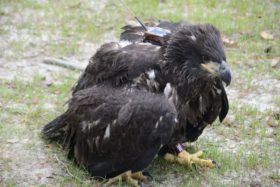Just How Common are 3 Eagles Eggs?
Azalea Returns to Alligator River NWR
February 12, 2010Valentine's Day at Alligator River NWR
February 14, 2010
One of the most frequently asked questions on the WVEC web cam chat is “how common is it for bald eagles to lay three eggs?”
Bald eagle surveys have been conducted in Virginia since 1977 when Dr. Mitchell Byrd at the College of William and Mary in Williamsburg and the Virginia Department of Game and Inland Fisheries (VDGIF) initiated the first systematic survey. Those surveys have been completed every year and beginning in 1991 have been conducted by The Center for Conservation Biology at the College of William and Mary with funding from the Wildlife Diversity Program of VDGIF. One of the principal objectives of the survey is to determine bald eagle productivity. Breeding activity and productivity is determined by two aerial flights. The first in late February to mid-March locates active nests. A second flight from late April to mid-May checks for nest productivity.
The numbers from the 2008 survey will give a measure of bald eagle productivity in Virginia. This is only one year and statistics over a period of time could be somewhat different. In 2008 there were 557 known active bald eagle nests in Virginia. Productivity in 15 (3%) of those nests is not known because vegetation was too dense to see into the nests. Of the remaning nests 97 produced no chicks (17%), 107 produced one chick (19%), 263 produced two chicks (47%), and 76 produced three chicks (14%).
2010 is actually the 5th year for the adults at Norfolk Botanical Garden to produce 3 eggs. In 2006, 2007 and 2009 3 eaglets successfully fledged. In 2008 3 eggs were layed but 2 were broken and only one egg hatched. That eaglet developed avian pox and remains at the Wildlife Center of Virginia. So, of the 7 years at NBG these adults have produced 3 eggs 5 times. Well above average.




9 Comments
Thanks for this great info Reese. I am hoping for another wonderful season like we had last year . Three beautiful and healthy eaglets.
I appreciate you giving us all of this great info.
Wish more would come here and take advantage of it.
Dixie
Hi Dixie, I come here every day! Reese, that is terrific information and a great track record for our pair. Thanks a bunch.
Reese, I found a website about the anatomy of an egg as it relates to the developing fetus of birds but no real scientific site that I trust. Would you be interested in posting something like that? You would definitely have my attention. This waiting is killing me (re: hatching). 🙂
FeatherFun – Yes, I will do a post on the miracle development within the egg shell in the next few days.
Oh that would be cool. Thank you!
I check in, too..and I don’t know “numbers” but I do hope many are taking advantage of this opportunity.
You made me even more aware how we can “see” without understanding. I saw the male covered with snow and the wind blowing and even though I know eagles endure this weather all the time, it was starting to tug at me a bit watching on cam. I was feeling the cold! Your explanation of insulation gave me an even greater appreciation how remarkably nature has equipped her creatures to adapt. Thanks 🙂
Reese, thanks for all the wonderful information you give us. I have learned so much about these wonderful eagles from this site and our forum. They are amazing. Can’t wait to see the info about the in egg development. That will be fascinating.
I think we all believe our pair is “above average” and now you have proved it with the numbers!!!
I, too, visit this site daily. The information is wonderful. I have learned so much. Thanks for taking the time to answer all our quesations and provide this wonderful learning experience.
Margy
Reese – do you think the number of eggs has to do with each particular pair of eagles? Some pairs seem to consistently lay 2 eggs while others lay 3 eggs. The Blackwater cam pair has laid 2 eggs except the first season on the cam. The NCTC eagles have also laid 3 egg clutches from 2006 to 2009, which were able to be observed on the cam. This year they laid 4 eggs, probably because the first two were lost in the snowstorms.
Paula – Many factors contribute to the number of eggs a pair lays. It takes a lot of energy for a female to produce an egg, so diet seems to be one aspect. Younger pairs tend to lay only one or two eggs. Both the male and female must be fertile. If a pair has an intruder during breeding, that may also have its effect. In 2008, the NBG pair laid 2 eggs then an intruder eagle drove them off the nest. A few weeks later they produced a 3-egg second clutch. Perhaps the first clutch would have been 3 eggs had it not been for the intruder. We just don’t know that.